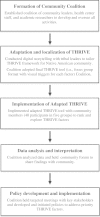Addressing food insecurity in a Native American reservation using community-based participatory research
- PMID: 21994709
- PMCID: PMC4719163
- DOI: 10.1093/her/cyr089
Addressing food insecurity in a Native American reservation using community-based participatory research
Abstract
The food insecurity faced by many Native American communities has numerous implications for the health and welfare of families. To identify and address upstream causes of food insecurity in a rural California reservation, we conducted a community assessment using the Tool for Health and Resilience in Vulnerable Environments (THRIVE). Guided by a community-based participatory research orientation, the THRIVE tool was adapted using digital storytelling and implemented in a series of focus groups. As a result of the THRIVE assessment, community members identified racial injustice and physical and financial barriers to accessing healthy and culturally appropriate foods as areas of greatest importance. Subsequently, the project partnership developed policies to reduce identified barriers which included an integrated community supported agriculture and commodity food program, the introduction of Electronic Benefits Transfer and culturally appropriate foods at the local farmers' market and reallocation of shelf space at the grocery store to include vegetables and fruits as well as special foods for diabetics. Results suggest that a participatory research orientation coupled with the use of a culturally adapted THRIVE tool may be an effective means for identifying structural determinants of food insecurity and initiating novel policy interventions to reduce health disparities experienced by Native American communities.
Figures
References
-
- Anderson SA. Core indicators of nutritional state for difficult-to-sample populations. J. Nutr. 1990;120(11 Suppl):1555–600. - PubMed
-
- Breckwich Vasquez V, Lanza D, Hennessey-Lavery S, et al. Addressing food security through public policy action in a community-based participatory research partnership. Health Promot Pract. 2007;8:342–9. - PubMed
-
- Cohen B. Community Food Security Assessment Toolkit (E-FAN-02–013) Washington, DC: United States Department of Agriculture, Economic Research Service; 2002.
-
- Drewnowski A. Obesity and the food environment: dietary energy density and diet costs. Am J Prev Med. 2004;27(3 Suppl):154–62. - PubMed
-
- Hill J. Obesity and the Built Environment: Improving Public Health Through Community Design; 2004 May 24–26. Washington, DC: National Institutes of Health Conference; 2004. Addressing the environment to reduce obesity.
Publication types
MeSH terms
Grants and funding
LinkOut - more resources
Full Text Sources
Research Materials


